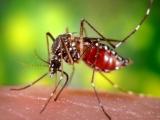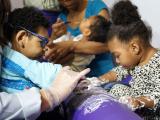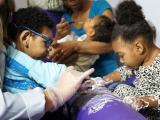Microcephaly screening for Zika complications in newborns might miss some birth defects, according to a long-awaited analysis of the first 1,500 suspected cases in Brazil, which revealed instances of brain damage in babies with normal head circumference, a team from Brazil reported yesterday.
In the largest case series to date, published in The Lancet, researchers from Brazil said screening criteria should be adjusted to include signs and symptoms of brain abnormalities.
In a related research development, pathology examination of postmortem samples from infants and fetuses from Brazil at US Centers for Disease Control and Prevention (CDC) labs revealed Zika antigens, cell damage, but no sign of Zika outside of the central nervous system and no indication that other pathogens are involved.
Defects in babies with normal head size
In the surveillance study, the researchers analyzed investigations completed as of Feb 27 by medical teams of 1,501 live-born babies with suspected microcephaly.
Using clinical data from Brazil's Ministry of Health, they grouped the cases into five categories based on neuroimaging and Zika virus lab findings. Categories ranged from definite microcephaly to discarded. The team also looked at head circumference, first-week mortality, and history of maternal rash.
Of the total, 899 cases were discarded. Among the remaining 602, 76 were definite, 54 highly probable, 181 moderately probable, and 291 somewhat probable. Compared with the discarded cases, definite or probable ones had small head circumference, and mothers were more likely to have had a rash during pregnancy (21% vs 61%). Infants in the definite and probable groups were also four time more likely to die during the first week of life.
The analysis also revealed brain abnormalities in babies with normal head size who were born to mothers who had a Zika-like rash in late pregnancy. The investigators noted that cranium development is generally complete by week 30 of gestation, so infants can be born with normal head size and still have brain damage. They also said the findings raise the possibility that Zika infection in newborns might lead to brain damage.
Cesar Victora, MD, PhD, the study's lead author, said in a Lancet press release, "Although we believe that the underreporting of microcephaly cases is rare during the epidemic, newborns infected with the virus late in pregnancy may go unreported due to their head size being within normal range." He also noted that about a third of the mothers of babies in the definite and probable group reported no rash during pregnancy.
Examination of all newborns during epidemic waves should be considered, Victora said, and he warned that because southern Brazil experienced a wave of Zika in early 2016, the country could see a second spike in microcephaly at the end of the year.
In a related commentary in the same Lancet issue, two experts from Brazil said adding new neurologic symptom criteria to detect Zika cases would be useful for identifying all affected infants, but many medical settings don't have the specialized personnel. The authors are Jorg Heukelbach, MD, MPH, PhD, a community health specialist from the School of Medicine at Federal University of Ceara, and Guilherme Loureiro Werneck, MD, PhD, with the epidemiology department at the State University of Rio de Janeiro.
Another option would be incorporating an accurate serologic test into routine prenatal care, and they said validation of such a test should be a research priority.
Damage in postmortem and placental samples
In the pathology study, also published yesterday in The Lancet, researchers from the CDC and collaborators in Brazil analyzed tissue from three babies born with microcephaly who died and two placentas from mothers who miscarried at 11 and 13 weeks' gestation. In all five instances, the mothers reported Zika symptoms during their first pregnancy trimesters.
In the three fatal cases, investigators found Zika antigens in neurons and glial cells. Brain tissue analysis showed cell damage, calcium deposits, and death. Unlike for other infections such as herpes, they found no sign of substantial inflammatory response or specific structural effects.
No evidence of Zika virus were found in other organ systems, and the three babies showed a range of birth defects and brain abnormalities.
In placental samples from the two miscarriages, investigators found Zika virus antigens. For all five cases, tests ruled out other infectious causes.
The authors said the mechanism that causes the birth defects still isn't clear, but it is probably related to the virus attacking the nervous system, resulting in brain damage and muscle impairment.
In an accompanying commentary, two US-based experts said though the CDC has concluded that Zika virus causes microcephaly, detections of Zika virus in tissues are scarce. The authors are Drucilla Roberts, MD, a pathologist at Massachusetts General Hospital (MGH), and Matthew Frosch, MD, PhD, a neuropathologist at MGH and Harvard University.
They said more detailed pathology studies are needed to identify the full spectrum of Zika virus infection and to confirm the link to perinatal complications. Roberts and Frosch also recommended that future studies should include histopathologic examination of tissue at different gestational ages.
"This report highlights that we can learn much about the pathogenesis of Zika virus congenital infection through careful pathological investigation, but leaves us with many questions for study," the two wrote.
Other developments
- The CDC today reported 4 more Zika-related birth defects in US pregnant women, raising the total to 12 as of Jun 23. Three of the new cases involved live births, and one involved a pregnancy loss. The number of Zika-related birth defects in the US territories remained the same, at one. In other numbers updates, the CDC reported 22 more Zika infections in US pregnant women (raising the total to 287), and 34 more in pregnant women in the US territories (raising the total to 250). Regarding infections in the general population, the CDC reported 166 more cases in US territories where the virus is spreading locally, most of them in Puerto Rico. The total in the region stands at 2,020 now, and 3 more Guillain-Barre syndrome cases were reported, boosting the total to 10. US states reported 115 more Zika illnesses in travelers, increasing the total to 934, plus 2 more sexually transmitted Zika cases, putting that number at 13.
- Though most Americans have heard of Zika virus, only 13% are aware of the impact on adults and only half know that the virus can spread sexually, the Kaiser Family Foundation reported today in a health tracking poll for June. The poll also found widespread support for Zika funding, including assistance with reproductive services for women in outbreak areas in and outside of the United States.
- The CDC on Jun 28 added Anguilla to its level 2 travel notice for Zika virus. There are now 49 countries or territories listed among the CDC's Zika travel advisories.
See also:
Jun 29 Lancet report on Zika microcephaly surveillance
Jun 29 Lancet related commentary
Jun 29 related Lancet press release
Jun 29 Lancet report on Zika birth defect pathology
Jun 29 Lancet related commentary
Jun 29 related Lancet press release





















